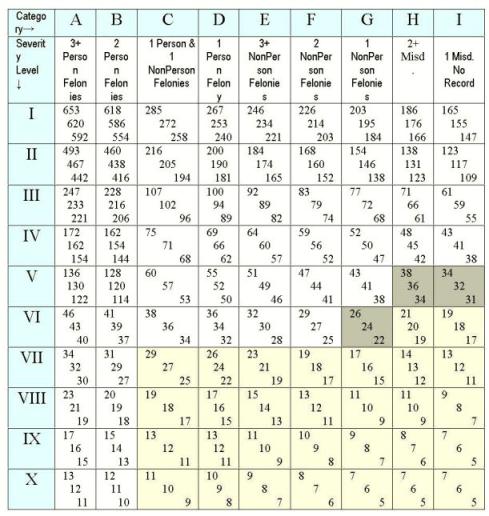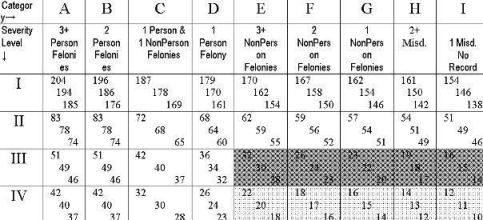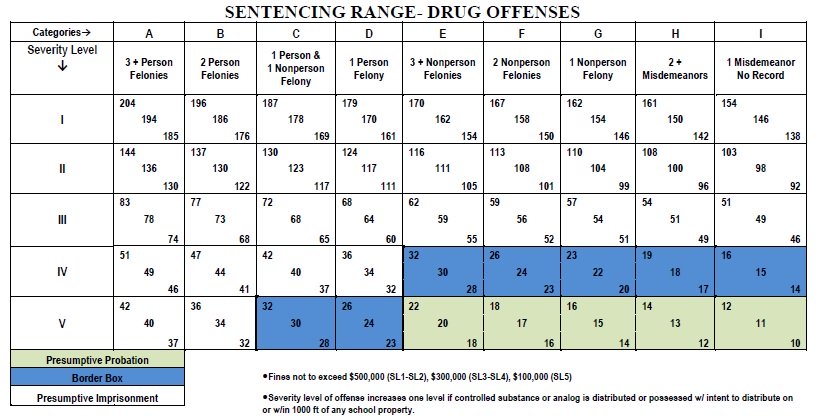|
Sentencing
Kansas judges sentence Defendants based on the Kansas Sentencing Guidelines which computes the sentence based on a combination of the severity level of the current conviction and the Defendant's criminal history. After a finding of guilt, based on either a plea or a verdict, the court orders a presentence investigation report or "PSI". The report is provided to the attorneys prior to the sentencing hearing and states the particular criminal statute upon which the conviction is based, the severity level of the conviction, lists the defendant's prior convictions, the standard sentencing range as well as any presumption for prison or probation and any special sentencing rules that may arguably apply. The defense attorney must verify the findings of the PSI with the defendant prior to the sentencing hearing and file any appropriate motions for relief. If there are any convictions listed on the criminal history that the defendant does not acknowledge are his then a certified record must be requested in writing from the prosecutor prior to the sentencing hearing in order not to prejudice the defendant's right to challenge the criminal history score (which is based on these prior convictions). The defense attorney must also examine the PSI to see if the defendant has any grounds to depart from the sentencing range stated in the guidelines. It is vitally important to know your criminal history score from the very beginning of a criminal charge. Each conviction will be derived from the violation of a criminal statute which must state the severity level (1 through 10) and type (person or nonperson) of crime involved in addition to whether the crime involves drugs. To illustrate this point, you must see the following Kansas Sentencing Guidelines Grids. The first grid has ten rows or "severity levels" and is used for non-drug crimes. The second grid is used to sentence those convicted of drug crimes and it has only four rows or "severity levels" for older cases and 5 rows for newer cases. The 5 level grid was enacted into law December 7, 2012 but we still have plenty of cases coming down the pike that will be sentenced under the old 4 level grid. The horizontal rows have roman numberals down the far left side which will correspond to the severity level of the crime charged. If you do not know the severity level of the crime charged, ask your attorney or look in the Charging Information.
In order to know the presumptive legal sentence for each individual defendant, a person must locate their criminal history score using the categories along the top which are located above each column on the sentencing grid. Where the criminal history column intersects with the row that denotes the severity level of the crime for which the person is convicted, the presumptive legal sentence is presented in the intersecting box or cell and is denoted as a range of three numbers. The middle number represents the standard sentence. The higher number represents an aggravated sentece which the prosecution will sometimes request if there is something particulary heinous about the facts of the case. The lower number represents a mitigated sentence which the defense counsel will sometimes request if the facts merit a reduction in the sentence. As long as the sentencing judge renders a sentence that is represented by one of the numbers in the appropriate box then the sentence is presumed to be legal. The following example is a hypothetical used to illustrate the basics of how Kansas Sentencing operates and will refer to the drug grid below. John Doe, the defendant, was convicted of possession of cocaine, a level four drug crime. He had never been in trouble with the law before. John's criminal history score is "I" because he has no criminal history and should be considered a person with "No Record". Therefore, John's presumptive legal sentence should be a range of 10-11-12 months to be served in the Department of Corrections (a.k.a. "prison").
Fortunately for John Doe, he will have the opportunity to be placed on probation and if he succeeds and follows all the terms of his probation, he will not have to serve any prison time. For both the Drug and Non Drug Grids, the lightly colored boxes on the grid represent presumptive probation sentences. For the more darkly shaded boxes, these are border boxes and the defendant can only get probation if his attorney files a motion pleading why his or her client is entitled to the probation. This usually requires the Defendant or his attorney to find a qualified vendor who can provide an offender reformation program and accept the client into the program. (This also means finding funding for the program.) The white boxes are for more serious crimes and those who have a more comprehensive criminal history and the legal sentence for those defendants will be presumption prison with no opportunity for probation. The drug grid with 4 rows is the older drug grid which we still use for older cases that take a long time to get to the sentencing phase. Newer cases are sentenced using the 5 row grid. The punishment levels for simple possession along the bottom row of the level 5 grid are exactly the same as the 4 row grid. So, if you see your attorney in court with an old drug rid, do not worry, it won't make any difference if you are up on a possession charge. The newer 5 row drug grid is depicted below.
If a drug crime occurs near a school zone the severity of the level of the crime will increase by one row, regardless of the severity level defined in the statute itself. Defense counsel will take this into account when counseling on the sentencing phase.
The concept of probation is more fully explored on its own separate
Probation Page.
Departure from the Sentencing GuidelinesMany Defendants find that their current charge, combined with their criminal history, lands them a prison sentence on the sentencing grid. In that case, the Defendant should ask the defense attorney whether he has any grounds to file a Motion to Depart from the Sentencing Guidelines. If such a motion needs to be filed it should state the current charge, the current status of the case, whether the conviction was reached by plea or verdict, any applicable negotiations with the District Attorney's office, the criminal history score stated on the PSI and whether it is being challenged along with any special circumstances that should be taken into account as well as the relief or appropriate alternate sentence you are seeking and whether the motion is by agreement with the District Attorney's Office. Specify whether you are seeking a dispositional (non-prison) or durational (shorter prison term) departure as well as any arguments related to concurrent (same time) or consecutive (back to back) sentencing for multiple counts in the same Charging Information. Your goal should be to persuade the court that mitigating factors exist in your case. Your defense attorney can advise you regarding the possible success or failure of a departure motion. Although there is some legal guidance available, these are mainly decided on a case by case basis.
The Defendant should be aware the prosecutor's office also has a legal right to ask the court for an upward durational departure to make your sentence more harsh than called for on the Sentencing Grid, should there be any special circumstances that constitute aggravating factors in the case. Sentencing for Convictions prior to 1993On May 2, 2014 the Kansas Supreme Court announced their decision in the State v. Murdock case which held that all convictions prior to the enactment of the Kansas Sentencing Guildelines Act on July 1, 1993 will be classified as non-person felonies pursuant to K.S.A. 21. 4710. On May 9, 2014 the Kansas Sentencing Commission issued an open letter to Criminal Justice Stakeholders advising us of the Murdock decision and to start applying the Murdock decision in our cases in progress. However, the Kansas Attorney General's Office has motioned the Supreme Court to reconsider it's ruling in the Murdock case and at this point their is no final decision on that request. That being the case, each individual practitioner must motion the trial court to apply Murdock. Criminal defendants and their families are advised at this time not to automatically assume that the Murdock law applies to them. Time will tell what eventually happens with the Murdock decision. Politicians who want to appear to be tough on crime must factor in the cost of incarceration to the taxpayers at over $18,000 per year per Defendant. Kansas prison capacity is over 9,000 inmates. $152,000,000 ($152 million per year) is the current bill. When the cost of incarceration exceeds the Department of Corrections budget employee pension plans go unfunded and must be paid back with interest. The taxpayers pay that interest. So, ultimately, is the extra cost worth the rehabilitation efforts to incarcerate a Defendant for a crime over ten years old?
|



